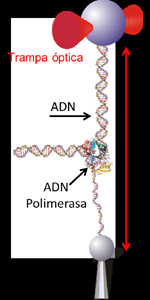Manipulando moléculas individuales de la ADN polimerasa del virus Phi29, el equipo de Borja Ibarra ha conseguido cuantificar por primera vez el mecanismo de apertura del ADN utilizado por esta proteína. Publicado en la revista PNAS, este trabajo ayudará a desarrollar nanomotores sintéticos.
 Muchas de las proteínas del interior celular funcionan como auténticos motores moleculares capaces de trabajar eficientemente a escalas nanométricas (mil veces más pequeñas que la de la célula). Para ello, transforman la energía disponible en el interior celular en diminutas fuerzas (picoNewtons: la diez millonésima parte del peso de un miligramo) y desplazamientos (nanómetros: la millonésima parte de un milímetro). Unos de los motores moleculares mas sorprendentes son las ADN polimerasas, las proteínas encargadas de duplicar la doble hélice del ADN que son capaces de leer la composición de bases de cada una de las hebras del ADN e incorporar la base complementaria en cada posición. Sorprendentemente, la polimerasa del virus Phi29 puede avanzar a lo largo del ADN a una velocidad de 6.000 bases por minuto a la vez que abre la doble hélice de la molécula y avanza por ella. Un corredor de obstáculos con estas propiedades sería capaz de correr aproximadamente a 360 km/h e ir saltando vallas separadas por solo 1 metro ¡sin tirar ninguna! Estas sorprendentes propiedades y habilidades de estos nanomotores biológicos, han fascinado durante mucho tiempo a los biólogos moleculares y en los últimos años a una amplia comunidad de físicos e investigadores del área de la nanotecnología.
Muchas de las proteínas del interior celular funcionan como auténticos motores moleculares capaces de trabajar eficientemente a escalas nanométricas (mil veces más pequeñas que la de la célula). Para ello, transforman la energía disponible en el interior celular en diminutas fuerzas (picoNewtons: la diez millonésima parte del peso de un miligramo) y desplazamientos (nanómetros: la millonésima parte de un milímetro). Unos de los motores moleculares mas sorprendentes son las ADN polimerasas, las proteínas encargadas de duplicar la doble hélice del ADN que son capaces de leer la composición de bases de cada una de las hebras del ADN e incorporar la base complementaria en cada posición. Sorprendentemente, la polimerasa del virus Phi29 puede avanzar a lo largo del ADN a una velocidad de 6.000 bases por minuto a la vez que abre la doble hélice de la molécula y avanza por ella. Un corredor de obstáculos con estas propiedades sería capaz de correr aproximadamente a 360 km/h e ir saltando vallas separadas por solo 1 metro ¡sin tirar ninguna! Estas sorprendentes propiedades y habilidades de estos nanomotores biológicos, han fascinado durante mucho tiempo a los biólogos moleculares y en los últimos años a una amplia comunidad de físicos e investigadores del área de la nanotecnología.
Clásicamente, el funcionamiento de estos motores se ha estudiado en tubos de ensayo donde millones de polimerasas trabajan al mismo tiempo en una reacción no sincronizada. De esta manera, muchos de los detalles del funcionamiento intrínseco de cada polimerasa se pierden en el promediado final. En colaboración con los grupo de José María Valpuesta y José L. Carrascosa en el Centro Nacional de Biotecnología del CSIC, de Francisco J. Cao en la Universidad Complutense de Madrid y de Margarita Salas del Centro de Biología Molecular “Severo Ochoa”, Borja Ibarra ha utilizado en su laboratorio del Instituto Madrileño de Estudios Avanzados en Nanocienca (IMDEA Nanociencia) la técnica de las pinzas ópticas para atrapar y manipular moléculas individuales de la polimerasa del virus Phi29. De esta forma estos investigadores han podido seguir la actividad de una sola molécula de polimerasa mientras trabaja y se desplaza abriendo la doble hélice del ADN.
En su estudio han encontrando que este diminuto motor molecular es capaz de acoplar la energía térmica con la energía química derivada de la incorporación de nucleótidos en la ruptura de los puentes de hidrógeno que mantienen unidas las dos cadenas del ADN. De este modo, se llegan a ejercer sobre la doble cadena de ADN fuerzas superiores a los 10 pN (1010 veces su peso). Escalando la polimerasa al tamaño microscópico, un motor del tamaño del de un coche con la misma relación fuerza-masa sería capaz de ejercer fuerzas efectivas iguales al peso de 300 millones de toneladas métricas, o el peso de unos 700 portaaviones.
Hace tan solo unos años la posibilidad de estudiar los sistemas biológicos a nivel de moléculas individuales parecía una historia sacada de algún libro de ciencia ficción, pero la implementación de avanzadas técnicas de manipulación de moléculas individuales tanto en el IMDEA Nanociencia como en el Centro Nacional de Biotecnología del CSIC está permitiendo que estas historias se hagan realidad. El estudio de los motores moleculares biológicos con estas técnicas esta permitiendo por primera vez en España el establecimiento de una amplia red de colaboración interdisciplinar entre biofísicos, biólogos moleculares y físicos. Además estos nuevos descubrimientos permiten conocer mejor el funcionamiento interno de las células y harán posible diseñar en el futuro nanomáquinas sintéticas que emulen la ingeniosa y eficiente maquinaria molecular diseñada por la naturaleza.





